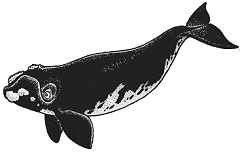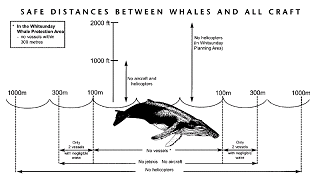 |
|

|
I
live in the sea: Whales and Dolphins
The giants of the sea!
courtesy
Great Barrier Reef Marine Park Authority
|
|
Up
to about fifty million years ago both
whales' and dolphins' ancestors lived
on land. As mammals, whales and dolphins
are warm blooded, have mammary glands
to suckle their young and need to
surface to breathe air. Since adapting
to life in the water, whales' and
dolphins' nostrils have moved to the
top of their heads and are called
'blowholes'.
They
have no hind limbs and their skin
is extremely sensitive and smooth.
Rather than having body hair to keep
them warm, they have a thick insulating
layer of fat or blubber under their
skin. Their bodies are streamlined
and their forelimbs are compact flippers
used for balance and steering through
the water.
Whales
are divided into two groups: those
with teeth and those without. Those
with teeth are known as toothed whales,
and include the sperm whale. Dolphins
and porpoises are actually small-toothed
whales. The other group of whales
is known as baleen whales, and includes
the blue whale and the humpback whale.
These species are larger and they
use baleen plates to sieve their prey
from the sea.
|

Along
the East and West coast of Australia
you are most likely to see Humpback
whales. In the southern waters Southern
Right whales are sighted on their migration
journey. Humpbacks have long fins while
southern right have shorter, broader
fins and rock like lumps around their
chin and head.
Drawing courtesy
Wet Paper |
| |
|
|

As
this humpback rolled onto its back
you get a
chance to see the barnacles and cookie
cutter
shark bites on it long wing like fin.
Photo courtesy Oceania
Project
Whales
and dolphins produce sounds (high-pitched
whistles and groans) to communicate.
Humpback whales are the most vocal
of all and produce elaborate 'songs'
that last for hours. Humpbacks
in the same area sing the same
songs and only the males sing.
Singing seems to be most frequent
at or near breeding grounds.
|
|
More
than 30 species of whales and dolphins
have been recorded in the Great Barrier
Reef. The most commonly seen whales
on the Reef are humpback and dwarf minke
whales.
Toothed
Whales
Whales with teeth are active hunters.
Some, such as killer whales, eat sharks,
seals, dolphins, birds, squid, fish
and even other whales. Beaked whales
and pilot whales all have teeth. The
largest toothed whale is a sperm whale
and can be up to 18 metres long.
Baleen
Whales
Whales without teeth have baleen which
consist of vertical plates fringed
with stiff bristles hanging down from
the upper jaw. Seawater is passed
through the baleen and schools of
tiny animals such as shrimp-like krill
and microscopic plankton are filtered
from the water.
Some
baleen whales are called 'rorquals.'
These whales have deeply grooved skin
around their lower jaw and throat
which forms a pouch that can expand
allowing the whale to take in large
mouthfuls of water. The tongue forces
the water out again, filtering it
through the baleen. Rorquals, found
in the Great Barrier Reef include
the humpback, minke and brydes whales.
Those baleen whales that don't have
throat grooves swim through the water
with their mouths open, allowing the
water and food to continuously flow
through the baleen.
Feeding
and breeding habits cause baleen whales
to undergo some of the longest migrations
of any animal. They spend the summers
in the polar regions because food
is plentiful with huge populations
of krill, plankton and small fish.
In winter, the whales move to warmer
tropical waters like the Great Barrier
Reef. Here they mate, or give birth.
|
| |
|
Female whales and dolphins give birth
to one live young at a time after a
ten to twelve month pregnancy. Most
whales give birth in warmer waters during
winter. For example, many humpback whales
migrate from the Antarctic to give birth
in waters along the Australian coastline.
At birth, their offspring, called calves,
can be over four metres long. The young
calves gain weight rapidly during the
first few months, however they remain
close to their mothers and accompany
them on the return journey of about
5000 kilometres to the Antarctic. After
one year, the calves have grown to eight
metres (more than half as long as their
parents) and are independent.
Whales and dolphins breathe air through
their lungs and therefore must surface
regularly. A small dolphin needs to
surface for air about every two or
three minutes. Baleen whales have
blowholes divided into two, while
toothed whales have a single blowhole.
All whales and dolphins can stay submerged
longer when feeding.
Whales and dolphins obtain much of
the information about their surroundings
from touch-sensitive organs in their
skin and from sounds in the environment.
Toothed whales, including all dolphins,
use the added facility of echolocation
to help them find food and navigate.
This highly sophisticated sense involves
producing a series of clicks that
travels through the water, echoes
off any object in its path and returns
to the sender for interpretation.
The sound is focused by fat deposits
in the animal's forehead and lower
jaw. This method of 'seeing' with
sound is similar to ultrasound scanning.
Toothed
whales seem to have the ability to
sense the Earth's magnetic field.
This assists them with navigation
but can also lead them astray. It
may be the reason for the mass strandings
of whales that occur from time to
time along the shoreline.
Since the beginning of commercial
harvesting many years ago, whales
were hunted in the Great Barrier
Reef for their blubber which was
boiled into oil for lighting,
lubrication, margarine, soap and
cosmetics. Their baleen or 'whalebone'
was softened and trimmed to make
stiffeners for clothes, whips
and umbrellas. However, as a result
of whaling it was not long before
whale populations began to dramatically
decline, with a 95% reduction
of the humback whale in Australian
waters over a decade. Today, all
whales are protected in Australian
waters and since the cease of
whaling in Australia in the early
1960s, their numbers have slowly
started to increase. There are
now believed to be around 5000
humpback whales and their population
is increasing at about 10% per
year. |
The
Blue Whale can be up to
30 metres long and is the
largest creature ever to
have lived. |
|
There
is concern about apparent declines
in populations of Indo-Pacific hump-backed
dolphins and Irrawaddy dolphins throughout
much of south-east Asia. Populations
of these species around Australia
may be the only ones that will survive
into the next century.
Globally,
despite restrictions on whaling, humans
continue to have an impact on whale
and dolphin numbers. Whales and dolphins
are subject to a wide variety of impacts
from human activities. Key human-related
impacts include whale watching, boat
strikes, and entanglements in nets.
Other impacts that are thought to
affect whales and dolphins are prey
depletion, pollution, noise and habitat
destruction from coastal development.
Indirect impacts on whales and dolphins
also include pesticides, heavy metals,
pollution, oil spills and other contaminants
accumulating in their bodies. These
threats are difficult to control and
the entire community should be aware
of our individual responsibility to
try to preserve these magnificent
creatures.
A
rare humpback on our doorstep
Recently, people visiting or living
along the Australian east coast have
had the rare and exciting opportunity
to see a white humpback whale. It
has been sighted over a number of
years and has created a lot of interest.
It was given the name Migaloo. In
2003 research was undertaken to see
if it is a really an allbino. |
|
· Do not kill, take, injure and/or
interfere with whales and dolphins. Interference
includes blocking their path, and harassing,
chasing and herding them.
· Be alert and watch for whales and
dolphins at all times when on the water.
· Avoid disturbance to mother whales
and their calves especially from June to October.
· Slow down to minimise the risk of
collision in areas where whales and dolphins
have been sighted.
· Be quiet when you are around a whale
or dolphin.
· If there is a sudden change in whale
or dolphin behaviour, move away immediately.
· Report sick, injured, stranded or
dead whales or dolphins to the Marine Animal
Hotline, phone 1300 360 898 (24 hr). |
|
· a vessel must not approach closer
than 100m of a whale or 50m of a dolphin
(or 300m of a whale in the Whale Protection
Area in the Whitsunday Planning Area)
· if a vessel is closer than 300m
of a whale or dolphin the vessel must be
operated at a constant slow speed with negligible
wake
· if there are two vessels within
300m of a whale or dolphin, all additional
vessels must remain outside a 300m radius
from the whale or dolphin
· you must not use a personal motorised
watercraft (including jetskis) closer than
300m of a whale or dolphin
· you must not enter the water closer
than 30m to a whale or dolphin
· you must not purposely touch or
feed or attempt to touch or feed a whale
or dolphin
· a fixed-wing aircraft must not
approach below 1000 feet or within 300m
of a whale or dolphin
· a helicopter must not approach
below 1000 feet or within 1000m of a whale
or dolphin
· in the Whitsunday Planning Area
a helicopter must not approach below 2000
feet or within 1000m of a whale.

|
|
|
|
|
